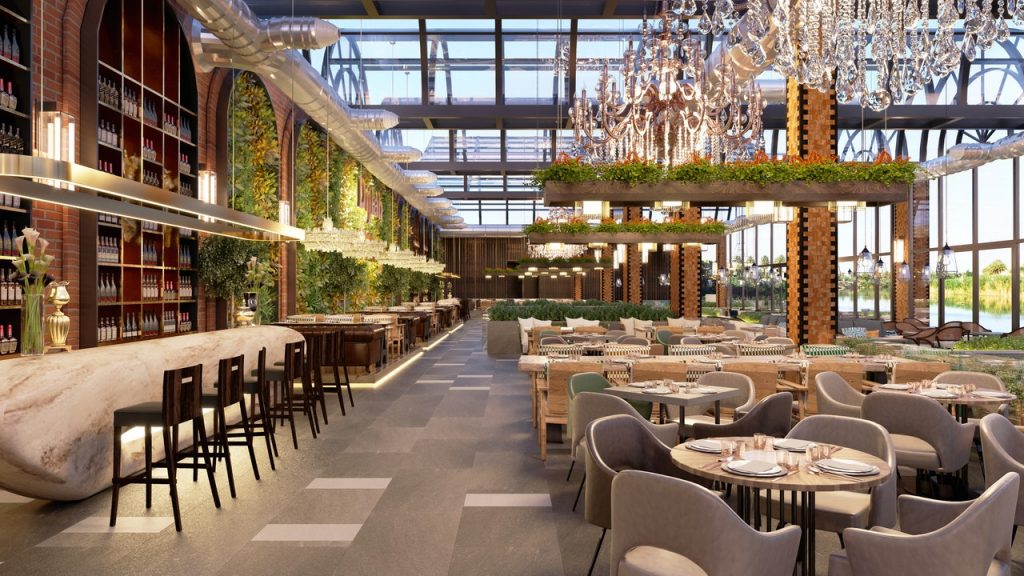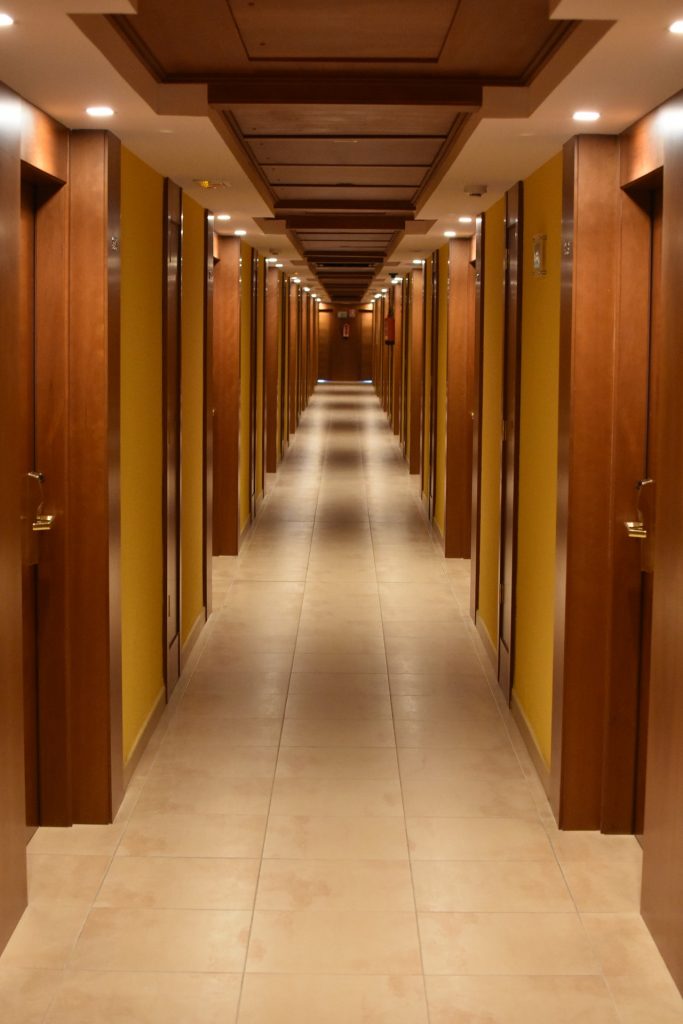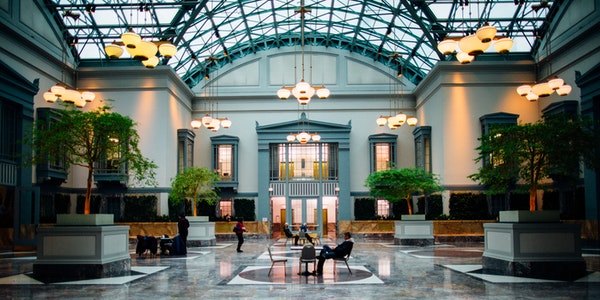Lighting Variable Design of Sub-function Area
- Restaurant space
The restaurant space is an important lighting area of the hotel. General hotels usually have Chinese restaurants and Western restaurants. These two types of restaurants have to be treated separately in terms of lighting design due to differences in functions and uses.
(1) Chinese restaurant:
It is often used for business or other formal banquets, so the overall atmosphere of the lighting should be formal and friendly. The illuminance of its general lighting is much higher than that of western restaurants.
The illuminance should be uniform, with little mood swings caused by brightness contrast. Point light sources, strip light sources or various types of lanterns can meet the requirements of good lighting. In order to make the quality and color of the dishes appear vivid and beautiful, to arouse appetite, the lighting of the table top is the key point. It is best to use a light source with high color rendering to set accent lighting above the dining table. If accent lighting cannot be provided above each dining table, the illuminance value of the general lighting of the restaurant should be designed to be higher.
In addition, manufacturers should attach great importance to light distribution when manufacturing lamps, so that the light has a three-dimensional effect. In the practice of restaurant lighting design, we use wall lamps or a number of spotlights to correct the flatness of general lighting, and strengthen the lighting to reproduce human figures, especially facial expressions and contours.
Illumination requirements: 200Lux for general lighting and 300Lux for accent lighting. As a supplementary side light, after the light beam of the light source reaches the illuminating object, the central light intensity is about 150cd. Color temperature requirement: about 3000K. Light and color requirements: uniform and coordinated. Color rendering requirements: Ra>90.
(2) Western restaurants:
Western-style restaurants are often used for informal business dinners, or dining places where the relationship between the diners is more familiar and close, so the overall atmosphere of its lighting should be warm and emotional. The illuminance value of its general lighting is much lower than that of Chinese restaurants. In addition, because the dining is informal, it does not require illumination of people’s faces and expressions. However, the accent lighting of the table top still has to make the dishes vivid and beautiful, and to make it easy for diners to access, so its color rendering is very important.
Illumination requirements: 50-100 Lux for general lighting, and 100-150 Lux for accent lighting. If there is a side light, you can use the light beam of the light source to reach the illuminating object, and the central light intensity is about 50cd. Color temperature requirement: about 3000K. Light and color requirements: uniform and coordinated. Color rendering requirements: Ra>90.
-
Room space
Hotel rooms should be like home, with tranquility, comfort and intimacy as the typical tone.
(1) Illumination requirements: 50-100 Lux for general lighting. The illuminance of the guest room is lower to reflect the characteristics of tranquility, rest and even laziness. However, local lighting, such as the lighting in front of the vanity mirror, the bedside reading lighting, etc., should provide sufficient illuminance, and the illuminance value of these areas can be 300 Lux. The most neglected is the writing lighting of the desk. At present, few hotels provide writing lamps (usually replaced by decorative lamps) for guests. As far as the hotel I have stayed in, only the Sunshine Hotel in Shenzhen has such lighting. This is a very humane lighting consideration. (2) Color temperature requirement: about 3000K.
Use a light source below 3500K in the bedroom, and use a light source above 3500K in the bathroom. The bedroom needs warm colors, and the bathroom needs high color temperature to be clean and refreshing.
(3) Color rendering requirements: Ra>90. Better color rendering, can increase the self-confidence of the guests, feel comfortable and good.
Insufficient hotel LED lighting renovation
High initial cost
When talking about the difficulties encountered in the application and promotion of current LED lighting products, the factor of “high cost” is the consensus of many people in the industry.
For the shortcomings of LED lighting in the hotel renovation, the biggest problem is the cost, especially the high initial purchase cost. Although LED lighting has obvious advantages over traditional lighting, it can save 60% of the electricity bill, but because the initial cost of LED lighting is too high, many hotels avoid it.
Calculated on the basis of the most common LED lamp, its price is 2-4 times that of the energy-saving lamps currently used. This is undoubtedly a huge amount of money for the hotel and catering industry that requires rapid capital circulation. And the luminaire requires more complicated optical, thermal and drive design.
For star hotels, the initial cost is generally not a problem. After operating for two or three years, considering the electricity bills saved every month and year, a lot of money can still be saved. The total cost of use will be lower than the total cost of traditional lamps. Many hotels are willing to try.
But for budget hotels, there is not much investment. If the price of LED lighting drops, they will also consider using it.
Manufacturers generally consider reducing the cost of LEDs from the aspects of large-scale production and yield improvement, technological innovation, and packaging. Moreover, the more urgent problem that the industry needs to solve is the reliability and cost reduction of the LED lighting system, which is also the key to fully enter the lighting field.

Immature technology——
Blindly advocating light effects, ignoring the color rendering index.
In the field of LED lighting, the hot spots that everyone talks about are that LEDs are more energy-efficient, have more applications, and higher luminous efficiency than traditional light sources. At present, most people in the industry focus on improving light efficiency, and it is not advisable to blindly pursue light efficiency. When looking at the luminous efficiency of LED, we must pay attention to its color rendering index. It is meaningless to only talk about luminous efficiency and ignore the color rendering index.
The color rendering index of LED lamps is a comparison value between the light source of the lamp and the sunlight, and the purpose is to reflect a value of the true color degree of a thing. In the LED lamp, it shows the influence on the brightness. The color rendering index is a key parameter that determines the quality and effect of the product.
Disadvantages of High CRI
Due to the limitation of lumens, warm colors and high color rendering cannot achieve the best results. LED lamps with a color rendering index above 75 are more popular. Because the superiority of its products is relatively high, that is, the color rendering index is high.
But the current problem is that the market does not have high requirements for the color rendering index. The manufacturer fixes the color rendering index when manufacturing the lamps. The method to improve the brightness can also be to replace the auxiliary material phosphor, silver glue, etc.
If you use high-end chips, you can also improve the color rendering index warm white tone. Generally, it is difficult for the color rendering index to exceed 80. Although it can be achieved, the luminous flux and the color rendering index are inversely proportional. If the color rendering index is high, the luminous flux will inevitably decrease. Brightness does not meet the set requirements.
The heat dissipation is difficult to guarantee
In recent years, some economically developed countries in the world have launched fierce technical competitions around the development of LEDs. Among them, LED heat dissipation has always been an urgent problem to be solved.
Research data shows that if the LED chip emits 100% light at a junction temperature of 25 degrees. When the junction temperature rises to 60 degrees, its luminescence is only 90%. Junction temperature is 100 degrees, it drops to 80%. And when the junction temperature is 140 degrees, the luminous efficiency is only 70%. It can be seen that to improve heat dissipation, it is very important to control the junction temperature. Heat dissipation is the most important issue in the design of LED lamps.
Existing LED lamp designs are often difficult to meet the requirements for heat dissipation. In areas where the heat dissipation requirements are very demanding, a very inferior passive heat dissipation method is used. And most of them are air-cooled or even closed air-cooled. For example, some lamps require a plastic sleeve between the driver board and the aluminum heat sink. This plastic sleeve can increase the reliability of the insulation. It also needs to be filled with heat-dissipating silica gel to improve the heat-dissipating capacity.



